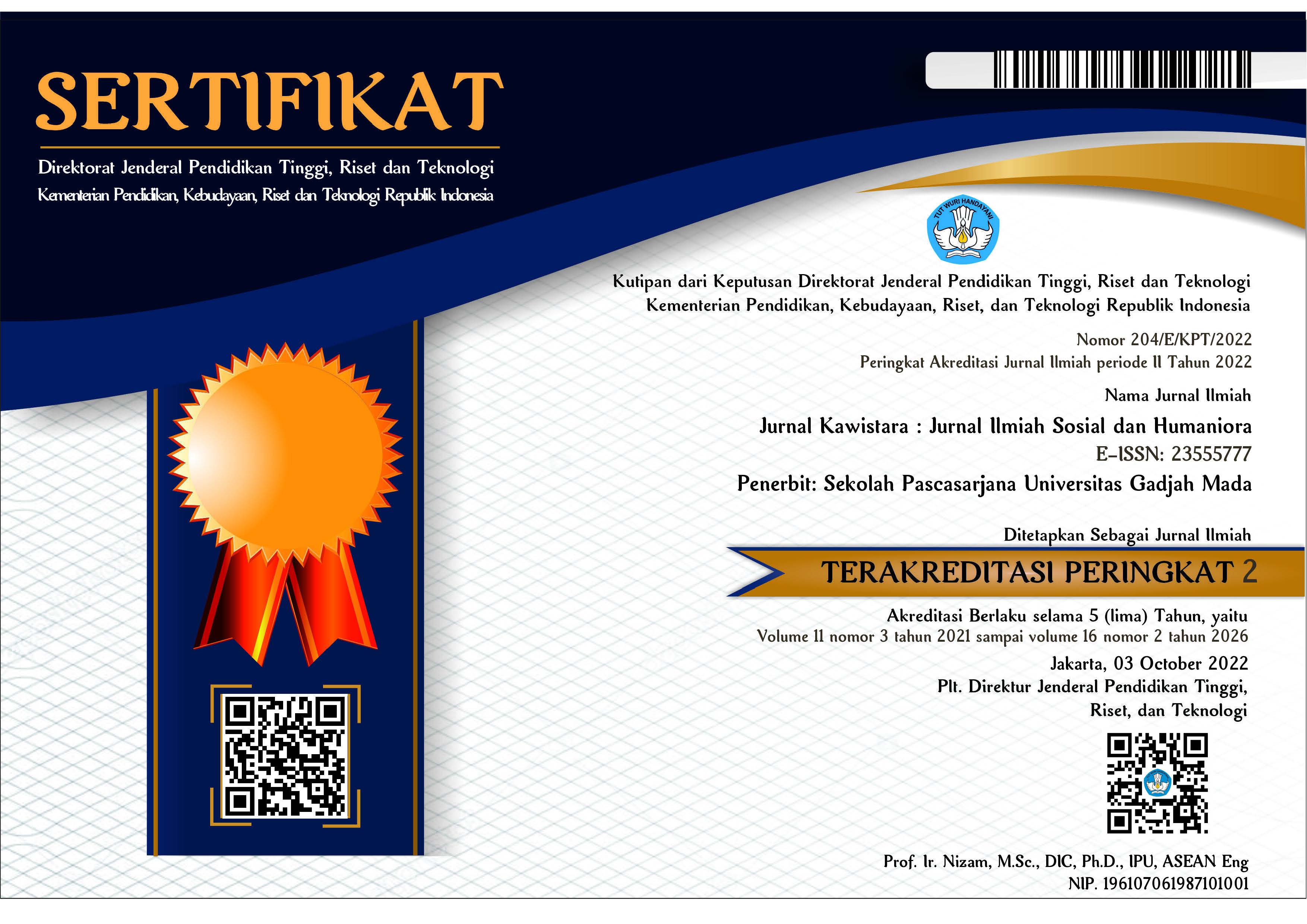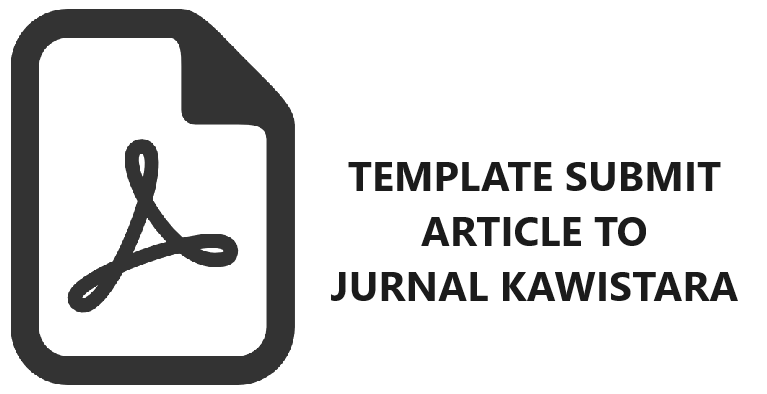Technology Negotiation in Dangdut Koplo’s Ecosystem and Practices
Michael H. B. Raditya(1*)
(1) Asia Institute, Faculty of Arts, The University of Melbourne
(*) Corresponding Author
Abstract
This article deals with the negotiation between the subgenre of Dangdut and technology. In this article, I articulate how agents of Dangdut Koplo use digital technology and how digital technology affects Dangdut Koplo’s ecosystem, cultural, and social practices. It is necessary to discuss Dangdut Koplo because it has several practices that are impacted by technology. Their practices elaborate on how society negotiated the use of technology. Dangdut koplo is one of the regional dangdut (dangdut daerah) subgenres that has developed in Indonesia, particularly East Java. Dangdut koplo emerged in the 1990s in Jarak Street, Surabaya, East Java. Furthermore, I will refer to two moments that demonstrated the impact of technology on the subgenre: first, the local people's activation of the local recording industry, and second, the activation of the internet and digital platforms by local people. I will elaborate on these to show the negotiation pattern between technology and their music, Dangdut Koplo. At the first moment, technological advances made people develop their local industries. The existence of local industries changed their economic and cultural patterns. Furthermore, middlemen in the music industry that Jakarta previously monopolized shifted to their surroundings. As a result, they could activate and directly control their economy and society. Then, the first moment developed rapidly in the second moment, when the internet changed society's social, economic, and cultural patterns. The internet allowed everyone to distribute their work. They could directly access consumers without the role of the previous middleman. Melayu Orchestra does not need a local music label or distributor with a solid fan base. They could distribute their works on the internet and digital platforms. This technological impact meant the Melayu Orchestra could compete with the local recording industry and vice versa. This pattern also changed their production processes, where digital needs made daily impressions, the development of Melayu orchestra personas on gadget screens, etc. Based on these developments, I elaborated on these questions: How did the ecosystem changes and its relationships impact the dangdut community? How is the dangdut community negotiating with technology? Utilizing digital data and observation data (obtained in 2017), I articulate how technological developments changed society's ecosystem and practice; and how society deals with technology.
Keywords
Full Text:
PDFReferences
[1]Auslander, Phlip. (1999). Liveness: Performance in a Mediatized Culture. London: Routledge.
[2] Benjamin, Walter. (1935). The Work of Art in the Age of Mechanical Reproduction. London: Penguin Books.
[3] Couldry, Nick (2008). “Mediatization or mediation? Alternative understandings of the emergent space of digital storytelling”, New media & society, 10 (3), pp. 373-391.
[4] Frederick, William H. (1982). “Rhoma Irama and The Dangdut Style: Aspects of Contemporary Indonesian Popular Culture”, Indonesia volume 34, pp. 103-130.
[5] Gunawan, FX Rudy. (2003). Mengebor Kemunafikan: Inul, Seks, dan Kekuasaan. Yogyakarta: Kawan Pustaka and Galang Press.
[6] Hakiem, M. Luqman. (2003). Tuhan antara Inul dan Gang Doly. Malang: Bayumedia Publishing.
[7] Heryanto, Ariel. (2009). Popular Culture in Indonesia: Fluid Identities in Post-Authoritarian Politics. London: Routledge.
[8] HT, Faruk dan Aprinus Salam. (2003). Hanya Inul. Yogyakarta: Galang Offset.
[9] Hudayana, Bambang. (1991). “Konsep Resiprositas dalam Antropologi Ekonomi”, Jurnal Humaniora No 3, 1991.
[10] Krakovsky, Marina. (2015). The Middleman Economy. New York: Palgrave Macmillan.
[11] Moller, Andre dkk. (2003). Inul itu Diva? Jakarta: Kompas.
[12] Raditya, Michael Haryo Bagus. (2013). Esensi Senggakan Pada Dangdut Koplo Sebagai Identitas Musikal. (Unpublished Thesis). Universitas Gadjah Mada, Yogyakarta.
[13] Raditya, Michael HB. (2021). “The Popularisation and Contestation of Dangdut Koplo in the Indonesian Music Industry”, in Adil Johan and Mayco Santaella (ed.), Made in Nusantara: Studies in Popular Music. New York: Routledge.
[14] Raditya, Michael HB. (2020). OM Wawes: Babat Alas Dangdut Anyar. Yogyakarta: Yayasan Kajian Musik Laras.
[15] Raditya, Michael HB. (2017). “Dangdut Koplo: Memahami Perkembangan hingga Pelarangan”, Jurnal Seni dan Budaya Nusantara, 1(1), pp. 10-23.
[16] Raditya, Michael HB and G.R. Lono Lastoro Simatupang. (2018). “Negosiasi Kultural dan Musikal Dangdut Koplo pada Orkes Melayu Sonata di Jombang”, Jurnal Panggung 28(4), pp. 433-451.
[17] Simatupang, G.R. Lono Lastoro. (1996). The Development of Dangdut and Its Meanings: A Study of Popular Music in Indonesia. (Unpiblished Thesis). Department Anthropology and Sociology, Monash University.
[18] Suhardi, Kathur. (2003). Inul lebih dari segelas Arak. Jakarta: CV Darul Falah.
[19] Sushartami, Wiwik. (2012). Representation and Beyond: Female Victims in Post-Suharto Media. (Unpublished Dissertation). Leiden University, Netherlands.
[20] Triwikromo, Triyanto. (2003). Inul! Yogyakarta: Bentang Budaya.
[21] Weintraub, Andrew N. (2010). Dangdut Stories: A Social and Musical History of Indonesia’s Most Popular Music. New York: Oxford University Press.
[22] Weintraub, Andrew N. (2013). “The Sound and Spectacle of Dangdut Koplo: Genre and Counter-Genre in East Java, Indonesia”, Asian Music Volume 44, Number 2, Summer/Fall 2013.
[23] William, Raymond. (1958). ‘Culture is Ordinary’, in Culture and Society. London: The Hogarth Press.
[24] Wurtzler, Steve (1992). She sang live, but the microphone was turned off: the live, the recorded, and the subject of representation. In Rick Altman (Ed.), Sound Theory Sound Practice (pp. 87–103). New York: Routledge. Internet
[25] Hahn, Michael. (2020). What is Midi? How to use most powerful tool in music. LANDR. Retrieved on 30 March 2022 from https://blog.landr.com/what-is-midi/#MIDI-definition
[26] Raditya, Michael HB. (2017). Pertarungan Identitas Dangdut dan Dangdut Koplo. Jurnal Ruang. Retrieved on 2 August 2021 from https://www.jurnalruang.com/read/1502688097-pertarungan-identitas-dangdut-dan-dangdut-koplo
[27] Wibisono, Nuran. (2017). Dangdut Koplo Puncak Evolusi Dangdut. Tirto. Retrieved on 30 July 2021 from https://tirto.id/dangdut-koplo-puncak-evolution-dangdut-cACw
Article Metrics
Refbacks
- There are currently no refbacks.
Copyright (c) 2022 Michael H. B. Raditya

This work is licensed under a Creative Commons Attribution-ShareAlike 4.0 International License.
Jurnal Kawistara is published by the Graduate School, Universitas Gadjah Mada.












